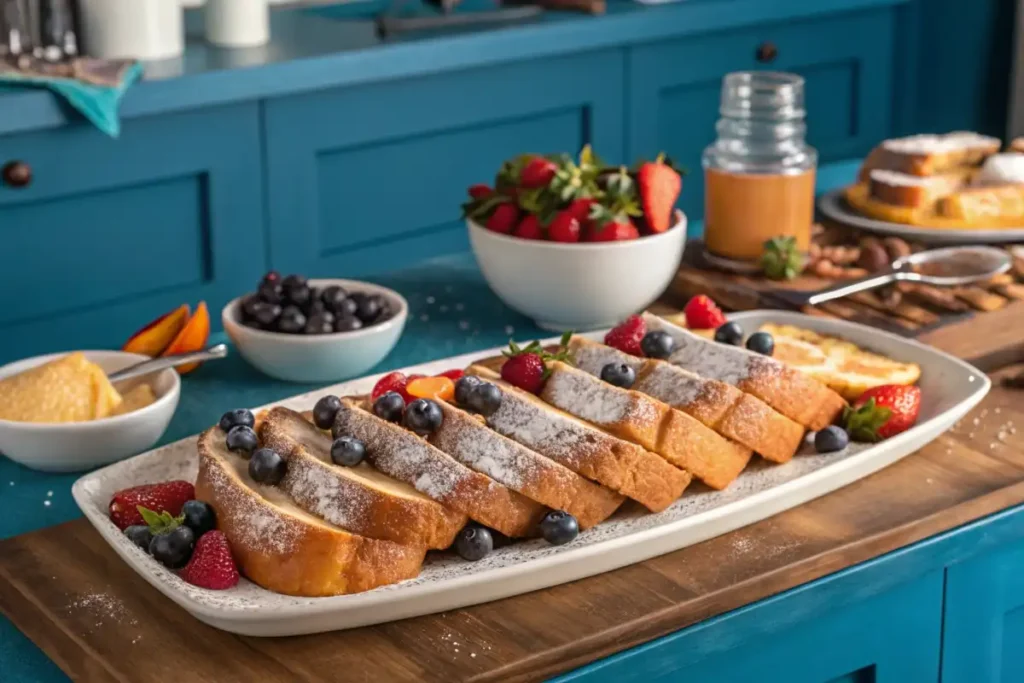Croissant French Toast – A New Sunday Tradition
At the present time, many breakfast lovers crave something more indulgent than basic toast. Therefore, consider upgrading your weekend brunch with croissant french toast. This delightful dish transforms buttery, flaky pastries into a tender and creamy breakfast treat.
Because the flaky layers of a croissant absorb the rich custard so well, each bite delivers velvety perfection.
Furthermore, this dish does not require professional skills. It simply needs good-quality croissants, fresh eggs, and a few aromatic spices.
In addition, croissant french toast offers a luxury that helps you start your day feeling pampered.
However, people often wonder if it’s too complicated to make at home. To demonstrate simplicity, we will guide you through the entire process step-by-step.
Eventually, you’ll realize croissant french toast is perfect for special occasions, holidays, or lazy weekends. In the meantime, prepare to discover how this dish pleases both your taste buds and your guests.
Above all, your friends and family will be impressed by your culinary creativity. In conclusion, this is not just another breakfast; it’s a versatile and memorable delight.
The Origins of Croissant French Toast
In contrast to traditional French toast, which typically uses stale bread, croissant french toast embraces the luxury of a French pastry. The origins of French toast reach back centuries, while croissants gained popularity more recently. However, the two combined create a modern twist that has taken U.S. brunch culture by storm.
To illustrate, classic French toast (known in France as “pain perdu” or “lost bread”) involved soaking old bread in a sweetened egg mixture.
Over time, creative cooks experimented with different bread types.
Eventually, croissants appeared as a perfect candidate. For instance, the buttery layers of a croissant absorb custard more evenly, resulting in a richer flavor and softer texture. Moreover, this combination resonates well with American brunch traditions.
It reflects both European elegance and American comfort. Therefore, croissant french toast stands as a culinary bridge uniting time-honored methods with contemporary indulgences.
Why Choose Croissants Over Regular Bread?
You may ask, why not just stick with the classic bread slice? First, croissants provide a distinctly flaky texture that ordinary bread cannot mimic.
Second, their buttery taste enriches the flavor profile, making additional butter optional. Third, because croissants are airy, they create a light interior when soaked, preventing a soggy, heavy dish.
Furthermore, croissants offer a subtle sweetness that complements the custard mixture. In addition, the layers crisp up beautifully on a skillet or griddle, providing a delicate crust.
In contrast, some bread slices remain too dense or become chewy. Hence, croissant french toast delivers a melt-in-your-mouth experience. To sum up, using croissants elevates the entire meal.
Ingredients You’ll Need for Perfect Croissant French Toast
To create restaurant-quality croissant french toast, you need select ingredients. Although you can tweak the recipe, start with these essentials:
- Croissants (preferably day-old and large):
- Flaky texture
- Buttery richness
- Eggs (preferably large and fresh):
- Rich custard base
- Protein for structure
- Milk or Half-and-Half (dairy or plant-based):
- Creamy consistency
- Helps the custard soak into croissants
- Vanilla Extract:
- Sweet aroma
- Enhances natural flavors
- Cinnamon and Nutmeg (optional but recommended):
- Warm spices
- Adds depth and aroma
- Salt:
- Balances sweetness
- Butter:
- For greasing the pan
- Adds a golden crust
For example, if you prefer dairy-free options, you can use almond milk or oat milk. In contrast, if you desire a richer result, choose half-and-half. In any case, always adjust flavors according to personal taste. Eventually, you’ll find the perfect balance.
How to Make Croissant French Toast Step-by-Step
Follow these instructions to make croissant french toast effortlessly. To demonstrate ease, we’ll outline a clear process. In the meantime, gather your tools: a mixing bowl, whisk, skillet or griddle, and spatula. Because simplicity matters, each step is straightforward.
Step 1: Prepare the Custard
- Crack the eggs into a large bowl.
- Whisk until yolks and whites combine.
- Add milk (or half-and-half), vanilla, cinnamon, nutmeg, and a pinch of salt.
- Whisk again until smooth and uniform.
At this point, taste the mixture. Although it’s raw egg, you can sense the aroma and consistency. Adjust spices if desired.
Step 2: Slice and Soak the Croissants
- Split each croissant in half lengthwise, or slice into thick pieces.
- Place the croissant pieces into the custard mixture.
- Let them soak for about 30-60 seconds per side, depending on thickness.
In contrast to dense bread, croissants absorb liquid quickly. Therefore, keep an eye on them. You want them moist but not disintegrating.

Step 3: Cook to Perfection
- Heat a non-stick skillet over medium heat.
- Add a small amount of butter to grease the surface.
- Transfer soaked croissants to the skillet.
- Cook for about 2-3 minutes per side, or until golden brown and slightly crisp.
Because cooking times vary, adjust heat if they brown too fast. In conclusion, the finished croissants should have a toasted exterior and soft interior.
Step 4: Serve and Garnish
- Plate the croissant french toast while warm.
- Top with fresh berries, sliced bananas, or seasonal fruits.
- Drizzle with pure maple syrup or honey.
- Dust with powdered sugar for an elegant finish.
At this point, your dish looks like it belongs in a gourmet magazine. Furthermore, consider a dollop of Greek yogurt or a spoonful of nut butter for extra protein.
(Joke break!)
What’s a croissant’s favorite dance move?
The “twist”—just like our French toast!
(Back to the recipe…)
Toppings and Variations to Elevate Your Croissant French Toast
In addition to the classic maple syrup drizzle, consider these creative toppings. For instance, top with a spoonful of lemon curd for tangy brightness. Alternatively, serve with whipped cream and berries for a dessert-like brunch. Furthermore, chopped nuts like almonds or pecans add crunchy contrast.
- Fresh Fruit Compote: Strawberries, blueberries, or peaches cooked down with a bit of sugar.
- Chocolate Hazelnut Spread: For a decadent treat that kids love.
- Coconut Flakes and Pineapple: A tropical twist that brings vacation vibes to your plate.
- Mascarpone or Ricotta Cheese: Light, creamy accents that complement the rich custard.
In contrast, if you prefer savory breakfasts, consider avocado slices, or a side of scrambled eggs. Although this is sweet and decadent, no rule prevents pairing it with savory elements. Eventually, you’ll find combinations that suit your taste buds best.

Expert Tips for Flawless Croissant French Toast
1. Use Slightly Stale Croissants:
Because day-old croissants absorb custard better, they hold their shape while cooking.
2. Don’t Over-Soak:
In contrast to stale bread, croissants are delicate. Therefore, keep soak time short to prevent sogginess.
3. Control the Heat:
Medium heat ensures even browning. In addition, adjust heat as necessary.
4. Serve Immediately:
Croissant french toast tastes best hot off the griddle. Eventually, it loses its crispness if left sitting.
5. Experiment with Flavors:
Try a hint of cardamom or orange zest. For example, orange zest offers brightness and a subtle citrus aroma.
Nutritional Data for Croissant French Toast
Nutritional information varies based on ingredients and portion sizes. The following data represents an approximate per-serving analysis (about 2 medium croissant halves):
| Nutrient | Amount per Serving |
|---|---|
| Calories | 420 kcal |
| Total Fat | 24 g |
| Saturated Fat | 12 g |
| Cholesterol | 180 mg |
| Sodium | 320 mg |
| Total Carbohydrate | 38 g |
| Dietary Fiber | 2 g |
| Sugars | 12 g |
| Protein | 12 g |
| Vitamin D | 10% DV |
| Calcium | 15% DV |
| Iron | 8% DV |
| Potassium | 6% DV |
This table serves as a guideline. For instance, using almond milk lowers cholesterol. In contrast, using half-and-half increases fat content. Therefore, adjust ingredients based on personal dietary needs. In addition, consider toppings’ nutritional impact. Eventually, choose options that fit your lifestyle.

Frequently Asked Questions (FAQs)
Q1: Can I make croissant french toast the night before?
Yes. To demonstrate time-saving, prepare the custard the night before and store it in the fridge. However, soak and cook the croissants fresh to ensure the best texture. In conclusion, this approach saves morning prep time without compromising flavor.
Q2: What type of croissant works best for croissant french toast?
Use bakery-style, large croissants with a flaky, buttery texture. In contrast, packaged croissants may be less flavorful. Eventually, fresh, high-quality pastries give superior results.
Q3: How can I make croissant french toast healthier?
To illustrate healthier tweaks, choose whole-grain croissants or use a lighter milk. In addition, opt for fresh fruit toppings over sugary syrups. This reduces calorie and sugar content without losing flavor.
Q4: Is croissant french toast suitable for a crowd?
Yes. At the present time, it’s easy to scale up. Cook in batches and keep pieces warm in the oven. Eventually, serve all at once. Because it’s elegant and delicious, your guests will feel special.
Q5: Can you freeze croissants?
A: Yes, you can freeze fresh croissants for up to two months. In addition, wrap them individually in plastic wrap. Then, place them in a freezer-safe bag. To reheat, thaw overnight and warm in the oven until crisp…
Q6: How to toast a croissant?
A: To toast a croissant, slice it horizontally. Place it in a toaster or toaster oven on a medium setting. Watch closely, as it toasts quickly. Remove when the edges turn golden-brown...
Q7: How to eat croissant toast?
A: Enjoy croissant toast warm with sweet or savory toppings. For example, spread honey, jam, or avocado. Pair it with eggs or yogurt for a balanced meal. Because it’s versatile, serve it anytime for a delightful treat…
Conclusion: Enjoying Your Croissant French Toast Experience
In conclusion, croissant french toast offers a delightful way to elevate your morning meal. At the present time, many people seek unique brunch ideas. Therefore, this recipe stands out as a sophisticated yet simple treat.
Because the flaky croissants and rich custard form a perfect match, every bite feels luxurious. In addition, you can customize toppings to suit your cravings.
Eventually, you’ll find that croissant french toast becomes a family favorite. Furthermore, it suits holidays, birthdays, or lazy Sundays. Above all, the process remains straightforward.
In contrast to complicated gourmet meals, this dish delivers impressive results with minimal effort. Therefore, embrace the opportunity to upgrade your brunch routine. In the meantime, spread the joy and share this dish with loved ones. To sum up, croissant french toast is an indulgent treat worthy of your table.
